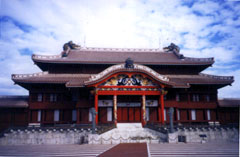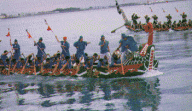A Very Brief History of Okinawa
Because karate (as we know it today) has its most immediate and most formative roots in Okinawa, one must know about the history of Okinawa to understand karate.
Okinawa is largest of the Ryukyu Islands, located several hundred miles east of southern China; several hundred miles south of the main islands of Japan; and several hundred miles north of the island of Taiwan. Its population is now over 1.2 million people, though most Okinawans live in the southern half of the island. The northern area is mountainous and sparsely populated; the south primarily urban and suburban. Indeed, today the crowding on the southern half of Okinawa is obvious to any visitor, exacerbated by the presence of several large US military bases, which occupy 20 percent of the total island and perhaps as much as one third of the livable space. This is a source of much resentment among contemporary Okinawans.
 Okinawa and the entire Ryukyu chain is now a prefecture of Japan, but it was, until fairly recently, an independent kingdom, at least in name. The Okinawan kingdom traced its roots to early 12th century, when independent, centralized kingdoms first appeared on the island. Beginning in the 14th century, the kings of Ryukyu looked to the Emperor of China for official investiture, receiving a measure of legitimacy in return for "official" appointment as vassals to Beijing. Tribute was sent to the Chinese capital at the coronation of each new king, and Chinese envoys visited Okinawa on many occasions over several hundred years on behalf of the Emperor of China. These envoys had a great impact on Okinawan society and culture, including karate.
Okinawa and the entire Ryukyu chain is now a prefecture of Japan, but it was, until fairly recently, an independent kingdom, at least in name. The Okinawan kingdom traced its roots to early 12th century, when independent, centralized kingdoms first appeared on the island. Beginning in the 14th century, the kings of Ryukyu looked to the Emperor of China for official investiture, receiving a measure of legitimacy in return for "official" appointment as vassals to Beijing. Tribute was sent to the Chinese capital at the coronation of each new king, and Chinese envoys visited Okinawa on many occasions over several hundred years on behalf of the Emperor of China. These envoys had a great impact on Okinawan society and culture, including karate.
Politics in Japan also played a critical role in shaping Okinawan history and karate. Following the establishment of the Tokugawa Shogunate in the 17th century, the Satsuma clan of Kyushu formally annexed the Ryukyu chain, mainly as means of capturing the Okinawan trade with China (which was officially forbidden by the Shogun). Satsuma political control of Okinawa was indirect, however, and the Okinawan kingdom remained officially an independent nation. Tribute missions to Kyoto were begun at this time as well, and Satusuma troops were stationed permanently in Naha and surrounding areas. Satsuma overlords encourage the cultural distinctiveness of the Okinawans, requiring the Okinawan tribute bearers to dress in Chinese clothing and to play Chinese musical instruments during their visits to Japan. This was meant to keep the Shogun from seeing the Satsuma conquest of Okinawa as expansion within Japan (at the expense of Shogun). Satsuma military presence on Okinawa was continuous from this time onward, significantly influencing local martial traditions.
 Throughout this period, Okinawan merchants and members of the Okinawan royal family continued to trade extensively throughout Southeast Asia. Historical records note trading from Korea to Sumatra and Siam. Most of the overseas trade, however, continued to be directed toward Southern China. Mercantile connections between Naha (the main trading port of Okinawa) and Fouzhou were extensive, and Okinawa became a node in a vast web of trade routes that reached as far as Europe. In Naha, a Chinese village was established (the legendary “36 families” of Kume Village) in the 1300s to help establish Chinese standards in industrial manufacture and business administration. British, French and Dutch records of visits to Ryukyu (Loochoo in some spellings) are evidence of the fact that many trading ventures, regardless of origin or destination, traveled through Okinawa.
Throughout this period, Okinawan merchants and members of the Okinawan royal family continued to trade extensively throughout Southeast Asia. Historical records note trading from Korea to Sumatra and Siam. Most of the overseas trade, however, continued to be directed toward Southern China. Mercantile connections between Naha (the main trading port of Okinawa) and Fouzhou were extensive, and Okinawa became a node in a vast web of trade routes that reached as far as Europe. In Naha, a Chinese village was established (the legendary “36 families” of Kume Village) in the 1300s to help establish Chinese standards in industrial manufacture and business administration. British, French and Dutch records of visits to Ryukyu (Loochoo in some spellings) are evidence of the fact that many trading ventures, regardless of origin or destination, traveled through Okinawa.
In 1879, following the restoration of the Emperor in Japan, Okinawa was annexed and made an official prefecture of modern Japan. The King of Okinawa “retired” to Kyoto at the request of the Japanese Emperor and Japanese civic administration was put in place throughout the Ryukyus. Many of the old, elite families of Okinawa lost their means of income (from hereditary rents or official offices), causing considerable social disruption. The Tokyo dialect of the Japanese language was required in all schools (as it was throughout Japan), and the very distinctive Okinawan dialect was discouraged. Japanese nationalism became public policy and the Chinese roots of much Okinawan culture and society obscured, denied or derided.
In the next several decades, many Okinawans were drafted into the Japanese Imperial Army as Japan expanded throughout East and Southeast Asia. In response, some merchant families sent their sons to "study" in China to avoid military service. Economic difficulties on the island also caused many Okinawans to move to mainland Japan, to seek work in the growing industrial manufacturing areas of Southern Japan, or to South America (where there remain large expatriate Okinawan communities). The island of Okinawa remained primarily rural at this time, and most of those who stayed on the island continued to farm as they had for centuries. Trade with China suffered, however, in part because Japanese aggression all over Asia disrupted old trading routes and relationships, and in part because Tokyo-based merchants had entered into the new colonial trade extensively, absorbing much that might previously have gone through Naha.
The Destruction Caused by WW II
World War 2 arrived on Okinawa in 1944 and turned the island into one of the bloodiest battlefields in human history. As the American military “island hopped” its way toward the Japanese mainland, the decision was made by the Japanese Army to fight a war of attrition on Okinawa, to delay the American invasion of the Main Islands of Japan. The Japanese High Command thought that every day the Allied forces spent fighting in Okinawa created another day for preparation against invation on mainland Japan. As a result, the Japanese Army on Okinawa fought a slow withdrawal from North to South, refusing to surrender even though it was obvious that defeat was inevitable. In total, a Japanese Army contingent of approximately 110,000 troops faced an Allied force of more than 550,000, who had complete air and naval superiority. Trapped between these two armies were a half million Okinawan civilians, many of whom remained only reluctantly Japanese and, at the same time, convinced by local propaganda that the American Army intended to exter,minate the Okinawan people. In the end the battle of Okinawa killed 30,000 Japanese troops, 10,000 American troops, and over 150,000 Okinawans. Ninety percent of the buildings on the Island were completely destroyed, and the lush tropical landscape was turned into a vast field of mud, lead, decay and maggots. The descriptions of this time are truly horrifying.
Following the end of the War, the American military retained control over Okinawa until 1973, when the entire Ryukyu Chain was returned to Japan. During this time large American military bases were created all over the island, both to support American wars in Korea and Vietnam, and as front line nuclear weapon air bases aimed at intimidating "Communist" China. Most of these military bases remain today (despite their unwelcome presence in the eyes of Okinawan people), largely because the Japanese government has pursued a policy of continuing base leases on Okinawa as part of their ongoing cooperation with the United States. This has caused many Okinawans to hold their own government partly to blame for the disruption caused by an unwanted American military presence. Yet, in part because of the bases and the long American occupation, Okinawa is closer to the United States in culture and personality than any other part of Japan or Asia (with the exception of the Philippines and those islands in the Pacific that remain under American control, like Guam). Many high ranking Okinawans were educated in the US as part of an Colonial policy of “Americanizing” Okinawa. And even today a large portion Okinawans remain at least marginally bilingual and have considerable familiarity with Americans and their ways. Indeed, while American pop music is popular all over Japan, many of the stars of the contemporary Japanese popular music scene are Okinawan.
See also:
Okinawa Plants and Okinawa Animals
Poisonous snakes of Okinawa
Traditional Okinawan pottery
